
Necklace Lengths for Jewelry-Making
Learning how to make your own jewelry can be a rewarding new hobby, whether you’re planning to sell your pieces in the future or just creating unique items for yourself and your friends. However, if you’ve never tried making jewelry before, it will take some time to master the basics. Before you try getting into a project that’s too complicated, you should start off learning how to create something on the easier side. Many people find a necklace or pair of earrings that they love and want to recreate right away, but many of the techniques required to create the piece are out of the realm of a beginner beader.
If you’re just getting introduced to jewelry-making, select one type of project to start with and keep practicing until you’ve mastered it. Necklaces are a great first project because there isn’t too much technical application that goes into it, and you can gradually introduce different techniques to enhance your pieces. Even if you’ve been making jewelry for a little while, there may still be some confusion on the exact accepted lengths for different types of necklaces. Follow this guide to basic necklace-making to get all the information you need to create a beautiful design you’ll be proud to wear.
SELECTING A NECKLACE LENGTH
When designing a necklace, the very first step is always to select your length because this is going to guide the rest of your design and determine the number and style of beads that you incorporate into the necklace. Although many people think that a small necklace would be easier, this isn’t always the case. For a tight, choker necklace, your measurements need to be very precise in order to have the choker properly fit around the neck without feeling or looking too tight or loose. If this is your first jewelry-making project, try starting with a medium or slightly longer length necklace. Somewhere right in the middle is usually the easiest to work with because the longer the necklace gets, the more beads you need and the more precise you need to be with your design to keep it looking consistent the entire way through.
DIFFERENT NECKLACE LENGTHS
Collar (12”-13”)
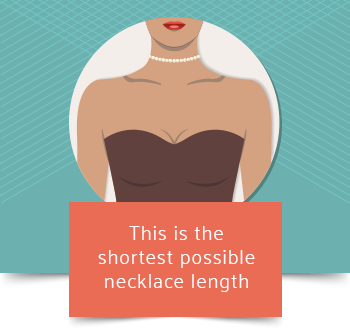
This is the shortest possible necklace length, which usually falls between 12 and 13 inches. When creating a collar necklace, it is supposed to fit, as the name suggests, like a collar, meaning it is tightly wrapped around the neck with very little space between the jewelry and your skin. The biggest challenge with creating a collar-style necklace is the ability to get the length exactly right—make it slightly too small and the wearer will be uncomfortable (or won’t fit around their neck); make it too big, and it no longer looks like a collar necklace. The most effective way to pull off this style is by first measuring the intended wearer’s neck to ensure that the string will be the proper length. Then, add another inch or two to make sure you have room to add the clasp at the end. Don’t worry–excess thread can always be cut off, but length can’t be added to thread that is too short.
Choker (14”-16”)
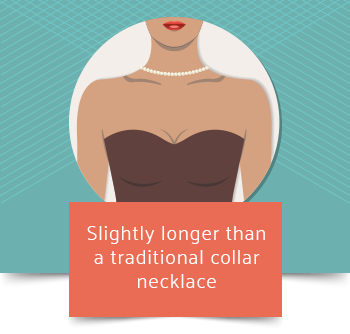
Many people assume that a collar and a choker necklace are the same, but chokers are actually slightly longer than a traditional collar necklace. Chokers fall between 14 and 16 inches. While a collar is supposed to stay secure at the middle of the neck, the choker necklace wraps tightly around the base of the neck. This look still requires a great deal of preciseness to ensure that the necklace is close to the skin rather than draping down onto the chest like longer styles.
Princess (17”-19”)

Between 17 and 19 inches, the princess necklace is one of the most common styles for necklace lengths. It creates an elegantly short necklace that falls just below the collarbone. This style is great for creating delicate freshwater pearl necklaces and goes well with strapless tops or dresses because the lack of material on the shoulders highlights the necklace itself.
Matinee (20”-24”)
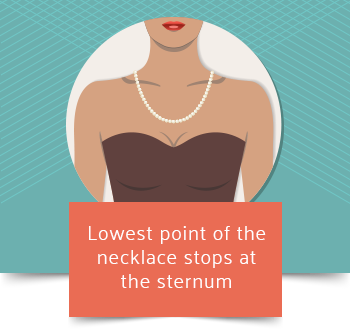
For an everyday, casual necklace, the matinee length works well. The lowest point of the necklace stops at the sternum, making it the perfect style to incorporate a unique pendant or large focal bead. Depending on your height, this style can fall at a different part of your body, so it’s a good idea to measure your thread and hold it against yourself to get an idea of where the center will fall.
Opera (28”-34”)

The opera length, which is between 28 and 34 inches, is typically saved for necklaces worn on a special occasion or can be worn as a statement piece with an otherwise plain dress or shirt. The focal point of an opera length necklace falls right at the breastbone, making this the center of attention, so many jewelry makers will add an attractive bead or pendant here.
Rope or Lariat (45” and up)
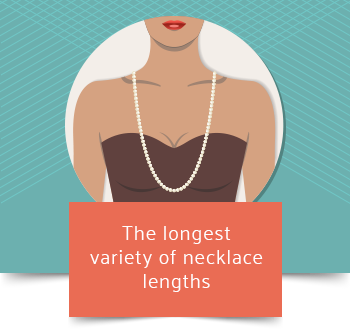
This is the longest variety of necklace lengths with each rope or lariat style starting at 45 inches. You can make this style longer if you desire, but it’s important to keep in mind that it becomes more difficult to maintain a symmetrical design the longer the thread. You need to practice a good amount of care and diligence to pull off this piece. If you want to try out a lariat for the first, you may consider simply adding a beautiful focal pendant or bead and using the same style bead to fill the rest of the necklace. This will make the creation process less complicated and allow the focal point to really shine.
TYPES OF BEADS FOR DIFFERENT NECKLACE LENGTHS
With so many necklace lengths to choose from, it can difficult to decide on just one. If you have a specific bead design already in mind, you want to make sure you’re going to pick a necklace length that really suits the type of beads and the pattern you want to create. These are some of our favorite types of beads to use for each length option. You can, of course, incorporate other styles of beads into a longer or shorter necklace to create dimension and variety, but be sure that the majority of your beads match the desired length.
Rondelle Beads
These round, slightly flattened beads can work well in nearly any design. For shorter lengths like the collar or choker, rondelle beads may be good for the majority of your necklace as they are attractive and large enough to allow the necklace to pop out against the skin. For longer necklaces, rondelle beads make great spacer beads, filling in the areas between your focal beads. Rondelle beads are available in both smooth and faceted options. The faceted style may not be ideal for tight necklaces because the edges may irritate the skin.
Round Freshwater Pearls
Again, almost any length can pull off round freshwater pearls because they are so beautiful and delicate. However, we recommend keeping this style short because the natural discrepancies in the size and shape of round freshwater pearls may become more apparent in a rope length necklace. If you’d like to include a single pendant with your pearl necklace, try one of the medium styles like princess or matinee.
Gemstone Beads
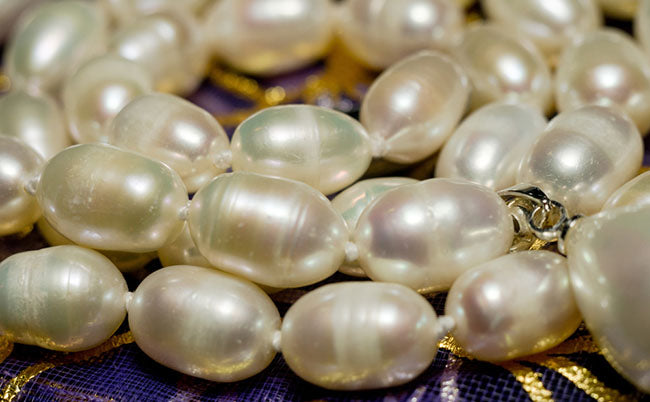
Gemstone beads are extremely versatile in jewelry-making and can easily be used for bracelets and earrings along with necklaces. However, this style bead tends to stand out more in longer length necklaces. A tight collar or choker made entirely of gemstone beads may risk looking a bit too casual or amateur, but an opera or rope length necklace made from all gemstone beads can work. Gemstone beads do make creative spacer beads for a variety of sizes, so it’s important to keep these around at all times.
Metal Beads
If you’re going to use metal beads, it’s best to integrate them sparingly to help them stand out against the other beads in the necklace. Some chokers look great with a full strand of metal beads and a single focal bead, but overall, using metal beads in longer lengths is a smart idea. Between the metal beads, you may want to incorporate sections of the same gemstone beads or other beads of the same color and variety to draw attention to the unique metal beads.
Focal Beads
Some collars and chokers incorporate a single focal bead, but these lengths are often more attractive without this addition. Focal beads are more important in longer length necklaces because it can draw attention to the lowest area of the strand and complement the wearer’s chosen outfit. This focal bead should also match the rest of the beads on the necklace in some way, so it’s important to select your spacer beads and focal bead together for the most polished, attractive result.

MAKING YOUR NECKLACE
Plan the Design
Before you can begin doing anything, you need to spend time envisioning how the final product will look. Without planning your design ahead of time, you may end up with a careless-looking piece. Try to create a rough sketch to get your thoughts together and then determine which necklace length makes the most sense.
Select Your Thread
Picking the right type of thread will be very important to how well your necklace holds up. If you’re planning to use large focal beads or heavy metal beads, you need to use a thread that can support the weight; otherwise, you’ll spend time creating a beautiful piece only to have it fall apart. If you’re planning to create a necklace with round freshwater pearls, silk is traditionally a great thread choice because it’s strong enough to hold the beads, but it can be difficult to work with. If you’re having trouble finding or using silk, nylon is a good alternative. Nylon is one of the more common thread types because it’s strong and can support heavier beads like gemstones, though there are many types of threads to choose from.
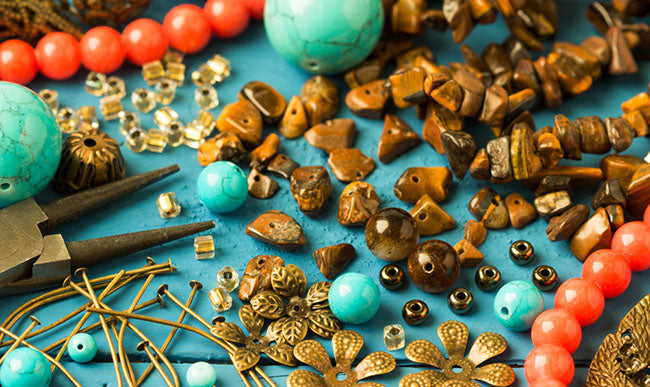
Pick Your Beads
You probably already have an idea of which types of beads you would like to use after planning out your design and selecting thread, but now that you have all your materials in one place, you should place your beads in the order you would like to arrange them. This will help you better visualize your final product and may even lead you to switching beads as you see how they complement each other. You should also spend some time determining how many beads you’ll need in between each focal bead to get it centered and to have each side be symmetrical.
OTHER TOOLS YOU’LL NEED
Spacer Beads
Your spacer beads are vital to the entire jewelry-making process because they are going to fill out the space between focal beads. Many jewelry makers will purchase spacer beads in bulk (and in different sizes and colors) so that when they come across a focal bead that inspires them, they already have plenty of spacer bead options on hand to match their desired design.
Stop Beads and Bead Stoppers
Though similar in name, stop beads and bead stoppers are very different in appearance and function. Both are intended to keep beads in place, but a bead stopper has the ability to be moved along the thread as you add beads. This tool is extremely useful when stringing beads because it can help you from losing the pattern as it slides along the thread, making it easier to count the beads and hold the design together. And, it prevents the beads from accidentally falling off the other side.
Bead stoppers differ from stop beads because they are movable and look like a spring with two loops on each end while stop beads are actual beads that are woven into the thread so they cannot move. This option is more commonly used with seed beading, but you can use it with any beads. You should just make sure to use the correct sized stop bead because if it is smaller than the rest, your other beads may end up simply sliding over it and off the string altogether.
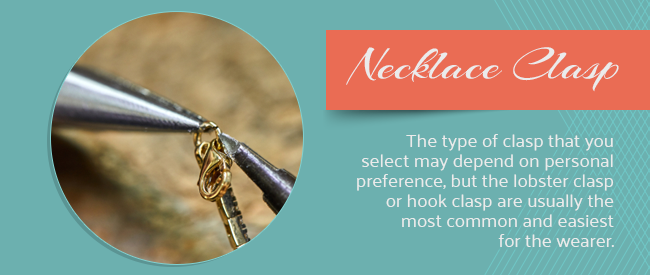
Clasp
Finally, you’ve strung all your beads onto your piece and you’re ready to turn it into a necklace. To pull the piece together, you’ll need some type of clasp. The type that you select may depend on personal preference, but the lobster clasp or hook clasp are usually the most common and easiest for the wearer.
SELECTING THE BEST MATERIALS FOR YOUR JEWELRY
To create high-quality jewelry, you need to use high-quality materials. The Bead Traders collection of beads includes a huge variety of designs, including round freshwater pearls, to make a gorgeous piece for any occasion. You can purchase all your materials in one place, so you can complete your necklace the moment you’ve finished the design when you incorporate our findings and clasps. Try out your first design or experiment with a new necklace length you’ve never worked with before.


